What’s in an idea? Ideas open possibilities. They open doors to change. They can push good beginnings and end bad practices. In this 25th year, we, at Teacher Plus, asked our contributors to share one big idea each that could mark a big change in schooling and education.
Some of the ideas featured here are a re-iteration of thoughts, some are serious, and a few can be implemented. But all of them could have a profound impact.
Of course, an idea remains just that until it is implemented. And for that to happen, it takes commitment and resources. But without an idea, there’s nothing. So here are some ideas – big, small, middling – that you could take on, give a shape to, and put to work in your own spaces.
Give me space
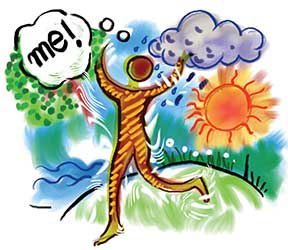 Give me freedom, give me space,
Give me freedom, give me space,
Give me the right to run my race.
Maybe forwards, maybe back,
Maybe just climbing up a rack!
Someone’s telling me all the time
Go there, come here, stand in line.
Must I shoulder my future now –
Bent, bruised, no idea how.
Must I learn to bend and bow,
Shackle my mind, even my toe.
I want to sing, I want to dance,
I want to shout till I’m in a trance;
I want to laugh, I want to cry,
I want to do what I enjoy.
I want to see the stars at night,
The sunrise at break of light,
How the oceans toss and turn,
Why my grandmother still wants to learn,
To feel the rain-drops on my nose,
The dew drop on my mother’s rose.
To watch the beetle roll balls of dung,
Or, to simply sit or stand or run.
I can’t see it in my books,
I can’t feel it in my teacher’s looks.
I don’t want to go to school;
They’re always telling me I’m a fool.
So maybe I’ll just fool around,
Find myself a cricket ground,
Or maybe better a mango tree,
Where no one’ll ever find me.
I’m not dumb, I’m not dumb,
I’m not just another bum.
I am me, just look at me
I just want to be ME, ME, ME.
Can you please let me be?
A little voice pleads with Ye!
B Ramdas
Viswa Bharati Vidyodaya Trust, Gudalur, Nilgiris, Tamil Nadu
The Indias outside
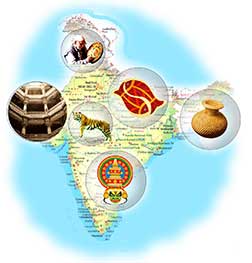 In a vast and polyphonous country such as ours, it is impossible for anyone to understand all of India and every subtlety of every region. Yet, a special burden that educated India carries is that it needs to speak for the millions who do not receive even basic schooling. I’d like to propose an open-ended course called The Many Indias Outside Our School as my single big idea for Indian education. We need to militate against the linguistic and regional chauvinism on the rise encouraged by divisive and cynical forces.
In a vast and polyphonous country such as ours, it is impossible for anyone to understand all of India and every subtlety of every region. Yet, a special burden that educated India carries is that it needs to speak for the millions who do not receive even basic schooling. I’d like to propose an open-ended course called The Many Indias Outside Our School as my single big idea for Indian education. We need to militate against the linguistic and regional chauvinism on the rise encouraged by divisive and cynical forces.
Let us bring together patriotism, geography and social history through technology and library research in a course that explores different locales of India through print and electronic media. Every week, a certain item anywhere outside the classroom and syllabus could be selected. Say the Stepwells of Gujarat for students in Andhra Pradesh or Tamil Nadu; the sacred groves of Tamil Nadu for students in Orissa; tribal art in Madhya Pradesh for students in Karnataka; the Kathakali art form of Kerala for students of W. Bengal and so on. Such a course would stir the imagination, help towards developing a composite picture of the native wealth of India and build a sense of national identity and pride in being part of a complex and ancient civilization.
Mini Krishnan
Editor-Translations, Oxford University Press, Chennai
How schools kill teachers!!
Dear Sir Ken Robinson,
This is what I felt like screaming
When I heard your Ted talks on schools and learning
I walked into a school all of twenty and one
Into a class of sixty ready to pull my bun
But by then I had decided to excel in my profession
Ready to make a difference in lives of each one
Who knew what I was in for!
I spend my days correcting books and papers
Well into many nights I sit and labor
I am out and about for election duties
Not to forget the numerous school committees
I too want to spark curiosity, develop creativity
I also want to cater to diversity
‘Why do I need a teacher when I’ve got Google?’ asks Gilbert
I also wonder and the answers hurt
Each period I am free, I want to run to a library
Alas! There comes a note to go for a proxy
They do send me to numerous trainings
Sadly, in them I find no meaning
All I ask for is just two periods a week!
To get together with few fellow teachers
Read up a few articles, watch and discuss a few speakers
Although my idea is small, I think it’s worth spreading
Professional development should be continuous and ongoing
Next time when you speak, can you speak on us… the teachers?
Shamim Ujjainwala
Freelance Educator and Consultant, Hong Kong
Chuck the book
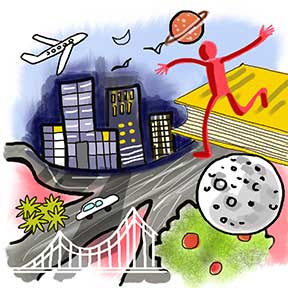 I am not from the tech bandwagon prescribing that students and teachers throw away printed textbooks and replace them with digital copies on a Tab or iPad. To me, the ‘textbook’ is a metaphor and physical construct for a constricted view of learning a set of demarcated content. It is this Holy Grail that needs to be chucked out – the one that teachers use to preach and examination boards choose questions from – to test learning. This readymade, instant mix, ‘Read it and you will know all’ textbook has no place in the 21st century schoolbag.
I am not from the tech bandwagon prescribing that students and teachers throw away printed textbooks and replace them with digital copies on a Tab or iPad. To me, the ‘textbook’ is a metaphor and physical construct for a constricted view of learning a set of demarcated content. It is this Holy Grail that needs to be chucked out – the one that teachers use to preach and examination boards choose questions from – to test learning. This readymade, instant mix, ‘Read it and you will know all’ textbook has no place in the 21st century schoolbag.
The idea that, “It’s good enough if I know what’s in the book” is falsely reassuring. We know neither employers nor situations limit themselves to ‘textbook scenarios’. A wider grasp of things from multiple sources – everyday experiences shared in class by the teacher and children, digital sources like the WWW, internships and field projects – are crucial preparation aids for the real world. While physical ‘subject’ textbooks promote the view of isolated disciplinary expertise, innovative solutions always come from interdisciplinary teams and approaches. Learning in subject specific silos reinforced by textbooks should break down to be replaced by transdiscplinary application of concepts.
The body of knowledge is ever increasing and changing constantly. Skills important today become irrelevant tomorrow. The ability to learn is more important than learning itself. A ‘textbook’ should not be the limiting factor to children becoming autonomous learners. Chuck the notion of “only the textbook”, not the textbook.
Venkatesh Datla
Co-Founder, Creya Learning, Hyderabad
Tech learning
Interactivity is the watchword of the 21st century, what with the advances in technology today. Technology has expanded the meaning of learning and literacy itself: for, to participate and be part of the digitized world, it is imperative for learners to be skilled in the use of technology in order to be able to access, explore, investigate into and organize information.
Technology has several advantages over traditional drill and practice methods. It offers students new opportunities to learn, not only by providing active engagement with tasks, but also enables participation in groups, with frequent interaction and feedback. It offers access to a huge store of information, enables multiple ways of understanding a concept (making scaffolding easy), and facilitates connections with real-world contexts, opening up the prospect of building new knowledge. The use of technology for learning is thus essential.
However, merely having an appropriate device with an Internet connection does not automatically lead to learning gains. What is required is a coordinated approach between all aspects of the school structure too – from curriculum to pedagogy and assessment, as well as other aspects such as teacher development, and potentially, parental and even societal involvement.
Sheel
Freelance editor and writer, Hyderabad
‘Texts’ beyond the textbook
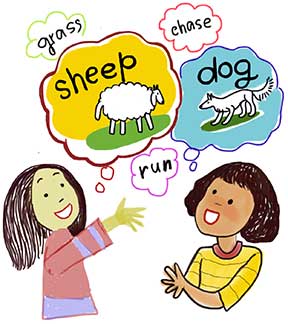 The meaning of the word ‘text’ is increasingly understood as not only the written word but anything that we can ‘read’ a message from. Patterns on cloth and on doorsteps, reliefs in clay, wood and stone, buildings, images, songs, films, advertisements, messages on mobiles, games, the landscape itself, artifacts and found objects – all can become texts that open us up to search for a deeper understanding of the world.
The meaning of the word ‘text’ is increasingly understood as not only the written word but anything that we can ‘read’ a message from. Patterns on cloth and on doorsteps, reliefs in clay, wood and stone, buildings, images, songs, films, advertisements, messages on mobiles, games, the landscape itself, artifacts and found objects – all can become texts that open us up to search for a deeper understanding of the world.
The word ‘text’ is related to the Indo-European root word ‘teks’ meaning to weave. A text can draw threads together to make new relationships and connections: the immediate locality can be a resource to explore history, geography, work, relationships and change; a carved doorway can trigger a discussion on materials, craftsmanship and fashion; a stuffed toy can evoke memories and dreams.
In Sanskrit the Sutradhar is ‘the threader of stories’ and each of us has a narrative to tell. The ‘text’ is not only something given readymade but texts can be generated by children to share with each other. The words we use are ancient and well-worn and yet for each person there are infinite possibilities to use and mean words freshly. Children need to explore, experiment and extend their world by looking at and creating a multitude of texts – verbal and non-verbal.
There is neither a single story nor a single textbook that can meet the needs of the enquiring student. Learning needs to be contextualized (‘woven together’) so that children’s lives outside and inside the classroom are plaited together to enable them to participate fully in both traditional and changing ways that ideas are being shaped and expressed. The texts we use in the classroom need to reflect a trust in the energy, interests and creative potential of children.
Jane Sahi
Teacher, Sita School, Bangalore
A resource centre
Children effortlessly absorb what is in their environment. They learn best by being in the presence of inspiring adults who are doing/pursuing what they are passionate about. To make learning more relevant, real, experiential and joyful, the school can be converted into a rich resource centre that opens up to people in the neighbourhood on specific terms and conditions of use.
The current school setup, which is an exclusive set of classrooms and labs (where children of the same age-group are uniformly taught the same set of things) can be transformed into an inter-generational hub of activity and learning. For instance, it can have an arts studio, where artists can work out of. Children can be exposed to and inspired by the working of mature artists, and can be encouraged to express their own creativity by experimenting with different media. Units for mathematical-modeling, useful crafts, music, printing, engineering design, astronomy, carpentry, weaving, etc., can be designed similarly. Depending on the specific type(s) of intelligence that a child has, (s)he should be allowed and encouraged to pursue streams of their choice, relieved from the pressure and burden of performing well in subjects that are not of interest to them!
Sangeetha Sriram
Unschooling mother, Chennai
Posing a problem
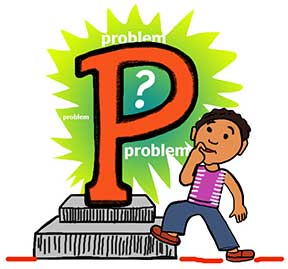 It is surprising why posing a problem does not find a prominent enough place in our school mathematics. While it is easy to see the benefits of encouraging children to develop their ability to pose independent mathematical problems, however elementary, it is mostly underutilized. This is a key curricular idea that can transform classrooms and trigger positive changes in school mathematics. It is difficult to see how the idea of ‘mathematisation of the world around us’ (NCF 2005) can be achieved with so little focus and emphasis on this essential component of mathematics. The contributions of mathematicians to posing a problem is considered as significant, if not more, than problem solving, both leading to the development of mathematical knowledge and thought (Eg. Hilbert’s famous 23 problems).
It is surprising why posing a problem does not find a prominent enough place in our school mathematics. While it is easy to see the benefits of encouraging children to develop their ability to pose independent mathematical problems, however elementary, it is mostly underutilized. This is a key curricular idea that can transform classrooms and trigger positive changes in school mathematics. It is difficult to see how the idea of ‘mathematisation of the world around us’ (NCF 2005) can be achieved with so little focus and emphasis on this essential component of mathematics. The contributions of mathematicians to posing a problem is considered as significant, if not more, than problem solving, both leading to the development of mathematical knowledge and thought (Eg. Hilbert’s famous 23 problems).
Posing a problem has additional benefits as it can be used as an excellent motivator, as a means to promote creativity in mathematical learning, encourage logical reasoning, to revisit and re-learn related mathematical concepts and their interconnections just to name a few. A careful deployment of it can also help teachers meaningfully assess children’s learning of the key mathematical concepts. The list can go on and it is important to draw up a detailed approach to do it gradually.
Lastly, problem posing must also be extended to other curricular areas – both sciences and humanities – with similar objectives.
S N Gananath
Director, Suvidya Resource Centre, Mysore
Honing skills
(I would like to talk about the second biggest idea about schooling. The biggest idea of course is to non-negotiably, unconditionally, categorically close down ALL schools, but let us talk about that some other day, OK?)
We call him Madhavettan, ‘ettan’ for elder brother because he is 61 years old, but also out of respect for his fine carpentry. He had come for some work one morning, when we remembered about the kitchen door that did not close. He apologized for having only a hammer and a broad-bladed chisel with him, held the door close to the frame, drew a line with the chisel, cut some pieces off the frame by hitting the chisel with the side of the hammer, and in three minutes had the door closing snugly. It was only a small task for him, but my wife and I were spellbound!
And later in the day, I was having a discussion with a friend whose son had just got admission to a good engineering college. We got talking about it and not amused by my tone she said, ‘At least say that you approve.’ I told her that I dislike this mentality in us and in our children to behave like sheep and she asked what option did I think children have? What better thing could they do?
I must admit that I didn’t think of it then, and anyway my friend may not have liked the idea applied to her son because of its current location on society’s value-chain, but don’t you think it would be nice if at least some of the people who come out of the schooling system could be proud, self-possessed, educated, skilled, craftsmen and craftswomen?
Arun Elassery
Wipro Education Fellow, WATIS, Bangalore
Independent learning
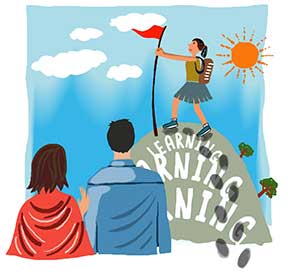 Indian mothers believe that a true indicator of their love is to make their children dependent on them. Mirroring the same perspective, our entire school system also seems geared to make students depend totally on teachers and textbooks for their learning.
Indian mothers believe that a true indicator of their love is to make their children dependent on them. Mirroring the same perspective, our entire school system also seems geared to make students depend totally on teachers and textbooks for their learning.
Schools do not encourage children to become fluent readers who enjoy reading. A typical school spends almost 30 per cent of its class time in conducting examinations which by and large are based on memorising content from the textbooks. Any question which does not have a direct answer in the textbooks is protested as “out of syllabus”. Teachers dictate ‘notes’. Students are rarely allowed to speak or discuss in class. Homework is completed with the help of the tuition teacher.
No wonder, in spite of all the ‘record breaking’ marks that students score in the Board examinations, there is very little original research emerging out of India. Even in the IITs, professors complain that after the 3 or 4 years in the ‘coaching factories’, students become incapable of learning on their own. Are we still perpetuating Macaulay’s dream of breeding only clerks?
The world we are living in is changing very rapidly. One of the most important skills students need to be taught today is to take responsibility for their learning.
Will our schools rise up to this challenge?
S Sundaram
Educational Consultant, Chennai
The VFC mantra
A flowing tide carries ships; a good tail wind carries birds along long distances. So also, when the mind goes along its intrinsic learning path, it achieves effortlessly.
In its natural state, the human child is playful, active, imaginative, curious and experimental. These are the very principles of enquiry, brain-based and discovery learning. So, do we use fun, stimulation of thinking, ‘what if’ questioning, enquiry-based activities, imaginative simulations, and experiments with variables to teach concepts in math, language, science, social studies and technology?
The mind also learns through exposure, repetition and meaningfulness. My big idea is VFC – a mantra to fix learning effortlessly. V is ‘volume’. For example, words are learnt through large incidental exposure in various media as opposed to dictionary meanings and tests. F is ‘frequency’. Spaced repetition of any learning is necessary to make learning permanent. So loop back to core information like concepts, principles, and terminology through quizzes, questioning and application. C is ‘context’. Learning becomes meaningful when real life problems in math and science, impact of ancient practices and people on contemporary life and cultures; or contextual vocabulary in comprehending rigorous passages are used.
So teachers, go with the tide, plan your lessons with Nature and VFC.
Usha Pandit
Founder, CEO, Mindsprings Group, Mumbai
The ‘big idea of subjects’
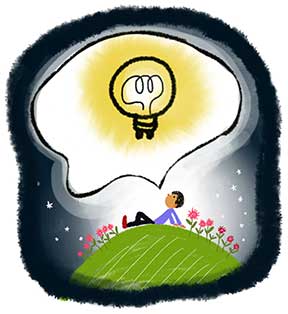 We ask a fundamental question to teachers – “Why do we teach the subjects that we do?” In most cases, the responses are limited, such as – “Math is everywhere” or “Math is used to count, measure, transact money”, and so on. To us, Math is all this and beyond – it is a systematic way of thinking and thinking in the abstract realm.
We ask a fundamental question to teachers – “Why do we teach the subjects that we do?” In most cases, the responses are limited, such as – “Math is everywhere” or “Math is used to count, measure, transact money”, and so on. To us, Math is all this and beyond – it is a systematic way of thinking and thinking in the abstract realm.
Education has been traditionally considered as a sustainable means for emancipation in a country such as India. In the initial decades after Independence, the focus was on basic literacy and numeracy. Over time, educators have been speaking of imparting skills that may enable students to live and perform in the real world, including acquiring job related skills.
We now face a world where change occurs at an unprecedented rate. This has brought with it newer challenges – both personal and professional – that have been hitherto unheard of. This also means that the world presents more opportunities for humans to analyze and attempt solving these challenges. We believe that the capability to think holistically, identify problems and make judgments based on carefully weighed options, are key abilities that education must aspire to. We also believe that the basic disciplines like languages, mathematics, sciences, history and so on inherently present us with ‘big ideas’, that is, opportunities to build these skills. The challenge is for the teacher to bring alive the ‘big ideas’ of each of the subjects in her classroom so as to make education relevant for every student.
Bala Subrahmanian
Head, educational partnerships, EZ Vidya, Chennai
The complete child
There is much to be gained from wholeness, soundness, completeness and comprehensiveness; these abstract words don’t mean much in the competitive context of our times. In our culture, there is so much talk of brilliance, “outstanding-ness” and everything superlative. Descriptions like ‘average, fair and able to cope’ are condemnatory and have a terrifying finality to them. There is no future for runners up. People love a winner. No one else counts. Teachers included. To most it is about marks and percentages and ranks!
What of those pupils who plod, aspire and want desperately to improve? Or for that matter, students who are apathetic, under-motivated or academically weak? Who is responsible for them and their future? A doctor (who is expected to know all about bodily health and disease), makes a diagnosis on several parameters. A teacher who is expected to “know” about the mental, intellectual and emotional health of her pupils, seldom bothers with a diagnosis behind the lack of progress in the educational growth of children who come under a larger category of those who are average and under.
A child is a complex blend of body, mind, and heart. We cannot slice away the mind from the body and heart, and cater exclusively to its health in isolation. Inherent talent, strengths and preferences are a part of the human package. The processes of learning are sensory, cognitive and effective, for everyone. Diversity of ability and interests in a classroom is a reality. One wonders where we lost sight of these facts and put training of the mind first to the exclusion of all else!
Enthusiasm, optimism, curiosity and interest are better tools and motivation for learning. They are surer paths to the goal of success. Success is a broad term. It must be based in terms of intrinsic motivation, the competences of problem-solving, critical thinking, creativity and entrepreneurship. This will make a student not only college and career-ready, but equipped to lead a life of participation and contribution. Schools must go beyond preparation for examinations and move to preparation for life.
Educating a whole child, intellectually, culturally, personally and professionally is an ideal KRA for every teacher today.
Pritam L Benjamin
Education Consultant and Faculty, Indus Training and Research Institute, Bangalore
The small big things
This decade has seen rapid changes in the education sector. It all started with online search, cool web portals; then to digital schools – from digital boards, to computer labs to tablets to e-learning solutions; and now the era of 3D printing is emerging. So everyone wants to know what is the next big thing in education? Instead can we reframe the question to ask, what are the small things to be done in education, which can make a BIG difference! A few small things which immediately come to mind are:
Making education even more inclusive: A kid coming from an economically and socially disadvantaged background should get a level playing field and opportunity to enhance the development of his / her body, intellect and soul.
Quest for Gold – The Indian Olympiad movement: As a nation, we need to resolve to make a mark in all international level competitions. Every teacher, every school needs to benchmark their efforts with respect to international benchmarks. We need to consciously start working towards the goal of becoming the top performing nation in the International Olympiads – sciences, mathematics, astronomy etc.
Sharing experiences across the ecosystem: The above section was for the Have Nots. Let me share some of my recent interactions with parents from the middle and the higher income groups and see what kind of challenges they face.
A father is looking for a tutor for his child who is good at sports but is weak in math. The father is a graduate from one of the reputed colleges in the country but finds it hard to digest the fact that his daughter is unable to cope up in math.
A middle-aged man in his early forties, brought his 13-year-old daughter and the question which he had was, “How good is my daughter? In school she keeps getting ‘A’ grade, but I am not sure what it is worth. How should I guide her further?” He was paying about Rs. 20k per annum for his daughter and was ready to shift her to a school with a fee of Rs. 50k per annum.
A friend’s child is now 5 years old and he can use a tablet and surf and play his favourite video on YouTube. He starts the application of his favourite game and is immersed in playing it. His parents have to test their negotiation/bargaining skills on the child to make him leave the device and engage himself with something else.
There are teachers, counselors, coaches, education experts, organizations who have very simple, tried and tested solutions to some or all these problems, which are big, stumbling blocks for the people facing them. It is important to create a simple, efficient and trustworthy system of sharing and dissemination of this knowledge.
It is worth mentioning about the initiative of sharing in the open, all such experiences, for the benefit of all teachers, principals and school managements. “Eklavya Sari” is the book which can be availed free of cost by writing to eklavya@eklavya.org. This is an initiative of a school named Eklavya, which is based in Ahmedabad.
 We need people to create solutions for translating information into all major Indian languages so that a vast majority of the population can also benefit from all the information available. There are many solutions which might seemingly be very complex for many, but would be very easy for some others. The solutions would emerge when our thinking shifts to what and how much can we give rather than how much we can take!
We need people to create solutions for translating information into all major Indian languages so that a vast majority of the population can also benefit from all the information available. There are many solutions which might seemingly be very complex for many, but would be very easy for some others. The solutions would emerge when our thinking shifts to what and how much can we give rather than how much we can take!
A game changer
I would like to begin by congratulating Teacher Plus on its 25th anniversary. I have been exceedingly pleased by the quality of articles it has consistently carried over the years, and I look forward to many, many, more years of educational excellence that the magazine delivers.
If there were one educational concept that I feel is truly a game changer, it is RPRP –getting the right person in the right part. Each individual has a nature that he is born with, and when people understand their natures they live in harmony with them.
In the old days, the guru identified the nature of the child and then decided his occupation according to his nature. Nowadays, anyone can study anything – and the results have been devastating: skyrocketing levels of job dissatisfaction, depression, drug use, suicide, and so on. We can counter these problems by learning from the wisdom of our ancestors by identifying children’s strong traits, i.e., their multiple intelligences and multiple natures, and aligning them with their professional pursuits.
The 8 multiple intelligences (created by Dr. Howard Gardner) include bodily, interpersonal, logical, linguistic, visual, musical, intrapersonal and naturalistic. My own multiple natures’ taxonomy includes these natures: protective, educative, administrative, creative, healing, entertaining, providing, entrepreneurial and adventurous.
I imagine a world where all children learn to identify their unique set of MIs and MNs, choose their career paths accordingly, and lead happier lives working as per their natures. If social networks can reach a billion people in under a decade, there’s no reason why we can’t expect today’s learners to grab on to this idea and make a tremendous change within one generation.
Steven Rudolph
Director, Jiva, Faridabad
The journey is important
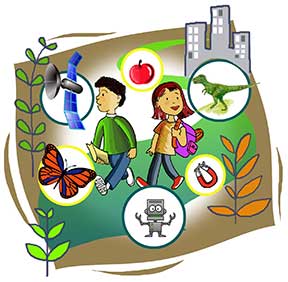 A boy in class 5 found ‘second language’ a bugbear. With a test looming on the morrow, he desperately memorized all the answers. But the ploy did not work. He had neglected to memorize the matching questions!
A boy in class 5 found ‘second language’ a bugbear. With a test looming on the morrow, he desperately memorized all the answers. But the ploy did not work. He had neglected to memorize the matching questions!
He failed the test, but learned a more valuable lesson than if he had passed.
Education is not only about knowing the answers; it is also about seeking out the questions.
The teacher told the class, ‘Learn something new every day.’
The next day she asked one child, ‘What new thing did you learn yesterday?’
‘Nothing, because I didn’t have the time to go and buy a new encyclopaedia.’
The teacher asked another child the same question.
‘I learned how to make my old toy car run again.’
Education is not only about knowing the unfamiliar; it is also about understanding the familiar.
‘What is your goal in life?’ This is the familiar question that every young student hears….from teachers, parents and career counsellors. What if that goal is ‘to land a good job with wonderful prospects for advancement?’ Nobody persists with the obvious question, ‘What comes next?’ Another goal? And after that?
Like Life itself, Education is not only about destinations; it is also about the journey… about reading the sign-posts, helping fellow-travellers who have lost their way, and spreading warmth and good cheer.
Education is a journey, a quest, an exciting adventure. If students don’t see it that way, whose failure is it?
Malini Seshadri
Freelance writer, editor and translator, Chennai
Self-learning and self-development
In contemporary times, the frameworks for understanding are evolving and changing rapidly. In this scenario, the focus of schooling cannot be to merely provide a certain set of information to the child during his formative years.
Against this backdrop it may be suggested that there is nothing more important than to empower the child with the art of self-learning and the aspiration to take on the task of self-development so that he may become a learner for life and work continuously towards self-perfection.
The methods of education must be consistent with the aim of education. And if our primary aim is to provide the child with the ability to reflect on his own self, to discover his strengths and weaknesses, to critically assess himself as a learner and discover for himself the methods by which he learns best, then, our current setup up of education needs to be changed drastically.
The child must have the freedom to choose his own subjects of learning and learn at his own pace. The role of the teacher in this new order will be even more crucial.
It will not be a simple task, as the apparent disorder would need meticulous organisation on the part of the teachers so that everything runs smoothly and harmoniously and every child moves forward on the path of self-perfection.
Chitwan Mittal
Director, Educational Innovations, Gurgaon, Haryana
More than a scrapbook
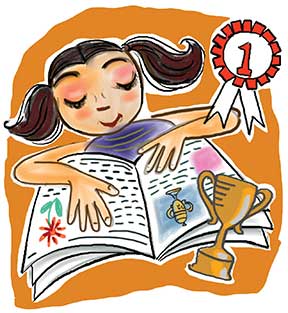 With a flourish school magazines blaze forth stunning results in examinations, sports, quizzes and all the inter-city/inter-state competitions. Photographs of captains, head boys and girls, prizewinners who make it to the newspapers, esteemed guests, beaming parents and glowing alumni comprise page after page of the annual magazine that does a school proud. There are also, typically, photographs of teachers with their classes, and class activities – visits to national parks, students attending extra or co-curricular workshops and pictures of creative work of outstanding students. Usually, a school magazine has a team of students working on it and it is the job (most often) of English teachers to put such a magazine together. And they do a good job of showcasing the readymade talent in the school.
With a flourish school magazines blaze forth stunning results in examinations, sports, quizzes and all the inter-city/inter-state competitions. Photographs of captains, head boys and girls, prizewinners who make it to the newspapers, esteemed guests, beaming parents and glowing alumni comprise page after page of the annual magazine that does a school proud. There are also, typically, photographs of teachers with their classes, and class activities – visits to national parks, students attending extra or co-curricular workshops and pictures of creative work of outstanding students. Usually, a school magazine has a team of students working on it and it is the job (most often) of English teachers to put such a magazine together. And they do a good job of showcasing the readymade talent in the school.
However, if schools are as much about encouraging the shy, the lazy, the uninitiated and the defiant as much as they are about giving opportunities to the eager beavers who naturally push their way to the front, a school magazine can be far more than a photograph album or a scrapbook. True, the administration of such a magazine does need the eager beavers – and one or two teachers who can call the final shots, but students who do not find a spotlight for themselves can be involved as photographers, typists and designers for the school magazine. These experiences give them a sense of worth and serve as confidence builders. Writing and art work need not only be extensions of brilliant class activities. Instead of complaining about class talkers, teachers can actually arrange for these students to research and then interview significant public figures.
Weaker students can be encouraged by their peers or their seniors to rework their articles and thus every member of the team can learn to take pride in both the individual and collective effort that culminates in a finished physical product.
I was in charge of the Phoenix magazine of The J.B.Petit High School for Girls, Mumbai, for many years and I feel that the experience has been as empowering and as demanding for me as it has been for every student who has worked on it.
Bubla Basu
Educationist and children’s author, Mumbai
Integrated thinking
The big idea I speak about is pedagogical integration. I limit it to mere points and examples from ICSE Class 8 History.
Integrate:
- Within: Link Akbar and Queen Elizabeth I, Shakespeare and Tulsidas, Tipu Sultan and Napoleon; also law of primogeniture and Mughal wars of succession, Third Carnatic War and French revolution.
- Interdisciplinarily: Link cultural perfusion to osmosis. Explain linkages, say, of Chemistry and History – gun powder changing the techniques of warfare; Willard Libby’s radiocarbon dating rewriting history.
- With literature, music, arts and films: I always teach American Civil War with the help of poetry and music extolling the leaders of the Union and Confederacy. Introduce the theme of slavery with Longfellow’s ‘Slave’s Dream’. Also connect JyotiraoPhule’s ‘Gulamgiri’ to it. The annexation of Awadh is taught by reading Premchand’s ‘ShatranjKeKhiladi’ and screening Satyajit Ray’s film. Teach British colonial oppression by singing Bahadur Shah Zafar’s’ ghazals.
- With documents: Distribute copies of Jahangir’s letter to King James I, Macaulay’s 1835 Minutes and Vivekananda’s speeches at the 1893 WPR.
- With books: Discuss British impact on India with Will Durant’s ‘A Case for India’ and Dharampal’s ‘The Beautiful Tree’.
- With theatre: Read and enact Girish Karnad’s ‘Tughlaq’ and ‘The Dreams of Tipu Sultan’.
- With school excursions: Trips to Lothal and Dholavira.
- With times past and present: A dateline simultaneously listing the regional, national and international events is one way. Interpret current affairs with respect to history; e.g. the regionalist politics of Maharashtra linked to the fall of the Maratha empire – their lack of national spirit.
- Contrapuntally: Introduce the arguments for Sati and the continuance of slavery.
- With the ideal: Stress on the absurdity of war and the immorality of imperialism. Impress the need to choose democracy and ecological sustainability to achieve the ideal of universal brotherhood.
Bhaskaramenon Krishnakumar
Principal, Anubhuti School, Jalgaon, Maharashtra.
The child and the Word
 If there’s one big idea that I think schools (and parents) need to adopt, it is to encourage Reading for Pleasure. Not for morals, not for learning, not for quantifiable benefits, but simply for developing a relationship between the child and the word.
If there’s one big idea that I think schools (and parents) need to adopt, it is to encourage Reading for Pleasure. Not for morals, not for learning, not for quantifiable benefits, but simply for developing a relationship between the child and the word.
The benefits that adults seek will accrue – how can they not when literature is all about the human condition! You just have to read a selection of contemporary children’s literature to discover that children’s books are amazing resources to discuss the complicated realities of our times. Love, friendship, inequality, war, disability, disease – there are books that talk of all this and more. And if a child reads those books, how can the child not think about these things. If you really want to know what they’ve learnt, then talk to them about what they’ve read – what they liked, what they didn’t, what was familiar, what wasn’t. And allow yourself to be less sure, less didactic, less grown-up when you do this. Don’t ask them what the moral of the story was. Don’t place a civilizing burden on books. Don’t kill the pleasure that lies between the covers of a book.
Encourage children to read for fun and for freedom, for magic and for science, for rationality and for irrationality and most of all, for irreverence. As Maurice Sendak said so eloquently in Where The Wild Things Are: Let the wild rumpus start!
Samina Mishra
Documentary filmmaker, writer, New Delhi
Nurturing a learning mind
“Much have I seen and known,” I might say, echoing Tennyson’s lines in “Ulysses,” as a parent, an educator and an explorer of educational initiatives. “I am a part of all that I have met; Yet all experience is an arch wherethro’ gleams that untravell’d world whose margin fades for ever and ever as I move.” And yet, there seems to be one unshakeable truth that is constant; the vital importance of nurturing a learning mind. Every one of us is born with this capacity to learn, but at some point does ‘schooling’ step in and kill the very thing it is seeking to bring about?
It seems to me that a learning mind is an open mind where no limits and barriers have been set up. It is a curious mind which receives, not passively but with alertness. It is a fresh mind that springs, not from the past, not from a future projection, but from the living present. It receives without resistance and opinions that are already formed. It may even be called a vulnerable mind which does not put up defences or reactions as a precursor to disagree!
As the adult who is one of the first contact points for the child, I ask myself how I meet a fresh mind. To be honest, I meet it with a ready package to be given. But supposing I paused to listen, despite large numbers, heavy workloads and other pressures? Ah, then…. perhaps I might learn something. What an idea!!
Usha Mukunda
Founder Member, Centre for Learning, Bangalore
A voice of their own
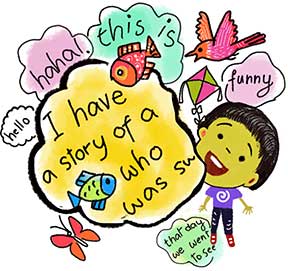 I don’t think that schools can be improved via any single stroke or activity. They are complex institutions, balancing multiple expectations of society, administrators, teachers, parents and children themselves, catering to differing aims of education and working through the historical processes through which they have become what they are today, and policy processes that are directing them forwards.
I don’t think that schools can be improved via any single stroke or activity. They are complex institutions, balancing multiple expectations of society, administrators, teachers, parents and children themselves, catering to differing aims of education and working through the historical processes through which they have become what they are today, and policy processes that are directing them forwards.
Schools today, unlike schools of the past, claim a space in human formation – in a very constitutive sense. It is useful to remember that the Right to Education is about compulsory schooling! In the process of giving ourselves this right, we have in fact agreed that the learning that we do in school is valuable and this education makes it possible for us to be humans living a life of dignity.
One of the reasons Indian schools need to be improved is because right now they don’t do this very well – they render so many children silent as if they were speechless. If I were to pick just one area of learning which would make a vital difference to education and which has the potential to revolutionize schooling, it would be language education. The focus of language often tends to be spelling, grammar, and handwriting. However, a language curriculum needs to enable children to learn to speak and read and write for expression, to clarify their ideas, to engage with others, to create and to enjoy the world; to find their own voice and construct their own identity. It is a powerful medium through which students can engage with both cultural and political history as well as transformation. I would vote for making a focused attempt to bring in such a curriculum which could engender such powerful learning of language. Its powerful and liberating effects, not only on the students but also on the teachers will have powerful consequences for other subject areas as well as the school as a space for education.
Padma Sarangapani
Associate Professor and Head, CHRD, ISEC, Bangalore
My BHAI!
Once upon a time, not so long ago, was the idea of a school as a content repository that required a teacher for transmission of this content to the newbie to the social order, i.e, the student.
All that, glad to say, has transformed. Thanks to the realization that sense is constructed, not transmitted, there is a growing recognition of the teacher as an activator/an animator, who keeps the lamp of curiosity inside staff and student burning bright. And of a school that is a learning organization, rather than a teaching one.
So if a school is to understand what learning is, undertake the task of providing a learning environment, and review its ability to undertake the task with a view to getting better at its key accountability, it is a 21st century organism.
My big, hairy, audacious idea (BHAI) for schools is: use self-review as a means of team building and alignment across stakeholders, grab the opportunity for peer review with both hands to be able to get miles better and look into the mirror with courage. The reward: a school that is aware, alive, systemically improving and persistently achieving.
Kavita Anand
Executive Director, Adhyayan, Mumbai
Bees over butterflies
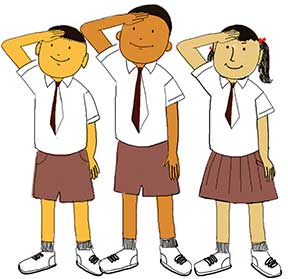 A typical educational institution dedicates its syllabi, time table, activities, drills, orientations and culture to building ‘leadership skills’. Every parent wants their child to be the staff bearer. Students spend 12 impressionable years internalizing this leadership goal. The virtual din on what makes a leader is matched only by a deafening silence on the ‘follower’. How many solo parades are we looking to build?
A typical educational institution dedicates its syllabi, time table, activities, drills, orientations and culture to building ‘leadership skills’. Every parent wants their child to be the staff bearer. Students spend 12 impressionable years internalizing this leadership goal. The virtual din on what makes a leader is matched only by a deafening silence on the ‘follower’. How many solo parades are we looking to build?
School councils are teeming with ‘appointed airheads’ who feel they have arrived and are now entitled to throttle back. Had they been brought up to be good followers first, they would do greater justice as leaders. For the qualities are identical, it is a matter of degree and focus. Ownership, courage, loyalty, methodical execution, tolerance, amicability, perseverance, trustworthiness are all hallmarks of a good follower just as they are of a great leader.
In addition to the current emphasis on spoken English, smart turnout, competition prizes, academic grades and parental support when selecting the School Council, schools would do good to assess the candidates on their ‘followership skills’.
This is the way forward to staying practical and inclusive. The more followers we build the more real leaders we stand to harvest. More bees than butterflies please!
Neerja Singh
Journalist turned teacher, New Delhi
Of discomfort and transformation
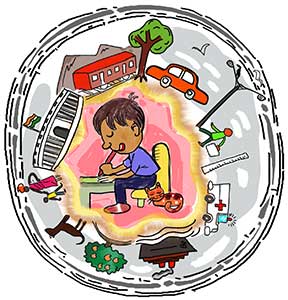 Dewey said it over a 100 years ago and we continue to recite – education is a social process and experience is education. Schools are a formalization of educational experiences. But in Indian schools, children are only expected to experience the formal syllabus. Other experiences are seen as pedagogical difficulties or avoidable circumstances. For example, experiencing the realities of economic disparity by being with classmates from “other” economic backgrounds, reflecting on the moral and political conflicts this raises would be “out of syllabus”. Schools are becoming antiseptic environments that educate groups that are in a convenient range of manageable diversity. Joyful learning is religion and hence children learn to avoid discomfort.
Dewey said it over a 100 years ago and we continue to recite – education is a social process and experience is education. Schools are a formalization of educational experiences. But in Indian schools, children are only expected to experience the formal syllabus. Other experiences are seen as pedagogical difficulties or avoidable circumstances. For example, experiencing the realities of economic disparity by being with classmates from “other” economic backgrounds, reflecting on the moral and political conflicts this raises would be “out of syllabus”. Schools are becoming antiseptic environments that educate groups that are in a convenient range of manageable diversity. Joyful learning is religion and hence children learn to avoid discomfort.
All educating necessarily aims for transformation. Schools have to intentionally create new and unfamiliar social experiences and build pedagogical methods and institutional processes such that children (and teachers) reflect on these experiences and learn from them. The more diverse the school environment is, the richer the educational experience will be. Transformation often comes with cognitive and emotional discomfort. This discomfort should not be seen as a problem resolvable by avoiding those situations, rather one should learn to reflect on these experiences and the discomfort in a manner that is constructive and educational.
Prakash Iyer
Faculty member, Azim Premji University, Bangalore
